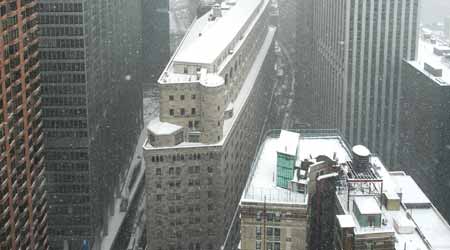 If a heavy snowfall is expected, it’s essential to keep roof drains open. Blocked drains can allow a dangerous amount of water or ice to accumulate.
If a heavy snowfall is expected, it’s essential to keep roof drains open. Blocked drains can allow a dangerous amount of water or ice to accumulate.Winter Is Coming: Protecting Roofs From Heavy Snow
Here are some tips for clearing snow from the roof in the event of a really ferocious storm.
In many parts of the country not threatened by hurricanes, the primary severe weather season brings ice, hail, and snow. Blizzards are usually also accompanied by high winds. However, one should consider that most roof systems only have warranties for up to gale force. A good healthy northeaster can easily reach that level.
During a bad storm, snow and ice present other problems, mostly relating to weight and drainage. Although snow is only between 15-20 pounds per cubic foot, drifts can pile up in corners. Two to three feet of snow may be enough to overload the roof. Fortunately snow does drift and does not necessarily end up in neat consistent layers so while one location on the roof may be under three feet of snow, other areas may be bare. Drifts may not cover the entire roof, but should they do so and the weight approaches the roof live load, try to remove as much of the snow as possible without damaging the roof membrane. By scraping the roof only to a thin layer of snow rather than going all the way down to the membrane surface, damage can be minimized.
A foot or less of snow probably doesn’t need to be removed unless ice has formed underneath. Ice weighs about 4.7 pounds per inch of thickness. Most roofs have a 30-pound live load. So you only need one half inch of ice under two feet of snow to exceed the design live load of your roof structure.
If you get snow storms, keeping debris from blocking your drains is even more important. When the snow begins to melt, the liquid water runs under the snow. If your drains are blocked, you may not be able to see the build up of the standing water and this invites a collapse if the water gets too deep. The water may freeze at night further blocking drainage.
Still, you need to be very careful after a blizzard about sending people up to the roof to clean off accumulated snow or thick layers of ice. Check with your structural engineer to be sure that the weight of the drifts is not at or over the load capacity of the roof. If it is close but it is still safe to allow people to go up to the roof, leave the mechanized equipment off the roof and use hand shovels. Don’t add any more weight to the structure than it can hold.
Preventing problems
The best time to think about how stormy weather affects your roof is when you are replacing it. Design the roof to suit the climate.
A dark membrane on a cold climate roof can help melt snow and ice. If you have many more heating days than cooling days, this choice in roof systems may be in your best interest. Reroofing is also the best time to add thicker insulation to the roof.
Adding slope to a roof in snow storm areas will allow two benefits. First, the melt water will drain off the roof faster, mitigate drifting, and allow snow to slide off, lessening the chance of an overload. However, a high slope can be as much of a hazard as a benefit. Heavy layers of snow can fall onto people below and the weight of the snow can cause injury. Installing snow guards on the new roof will slow heavy snow layers from falling down and lessen the problem. With high slopes you can also get ice dams that can allow water to back up under the edge of the roof causing leaks. Sealing the edges of high slope roofs by continuous waterproofing underlayment can mitigate the problem.
If you get hail, pay attention to the substrate under the roof membrane. Research has shown that roof membranes installed over insulation boards directly suffer more hail damage than those installed over stiffer substrates like OSB or plywood. An extreme analogy would be shooting a gun into a pillow and a steel plate. The soft pillow will not provide any resistance to the bullet and it will pass through. The stiff steel will resist the bullet penetration.
With hurricanes, wind uplift design is extremely important. The number and placement of fasteners used to attach the roof will determine whether the roof will stay in place. Edge conditions need to be designed to withstand the higher wind pressures at perimeters and corners. Mechanical equipment should be re-installed on stands secured to the structure and strapped down to prevent movement during the hurricane. Consideration should also be given to the puncture-resistance of the membrane as wind blown debris can easily cut thin unreinforced membranes. Fully adhered membranes will reduce the chance that wind will get under cut membranes and create pressure from underneath.
A qualified consulting architect or engineer can help you decide on the best system for your climate, building construction, and use.
Karen L. Warseck, AIA, LEED AP, is a registered architect and president of Building Diagnostics Associates, specializing in investigating the causes of cracks and leaks in roofs and walls of existing buildings and designing remedial construction to fix them. She is a contributing editor for Building Operating Management. She can be reached at kwarseck@buildingdiagnostics.com.
Email comments to edward.sullivan@tradepress.com.
Related Topics:














